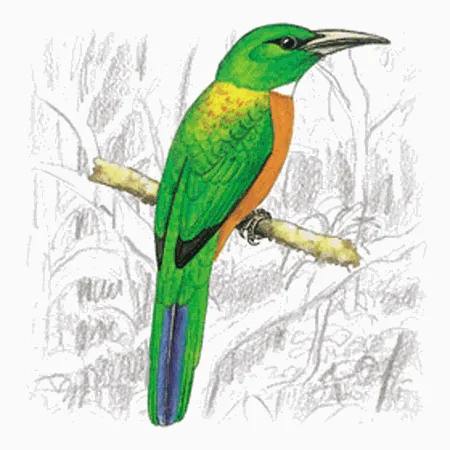
Great Jacamar
[order] PICIFORMES | [family] Galbulidae | [latin] Jacamerops aurea | [UK] Great Jacamar | [FR] Grand Jacamar | [DE] Breitmaul-Glanzvogel | [ES] Jacamara Grande | [NL] Grote Glansvogel
Subspecies
| Genus | Species | subspecies | Breeding Range | Breeding Range 2 | Non Breeding Range |
| Notharchus | aureus | ||||
| Jacamerops | aureus | ||||
| Jacamerops | aureus | LA | Costa Rica to nw Ecuador, Amazonia | ||
| Jacamerops | aureus | aureus | e Colombia, Venezuela and the Guianas | ||
| Jacamerops | aureus | isidori | e Ecuador, e Peru, w Brazil and n Bolivia | ||
| Jacamerops | aureus | penardi | Costa Rica to w Colombia | ||
| Jacamerops | aureus | ridgwayi | ne and c Brazil |
Physical charateristics
Largest jacamar 30 cm long, with thick, slightly curved bill. Metallic green upperparts, white narrow band on throat, rufous underside, with bluish black underside of tail. The female is essentially the same but lacks the white throat patch. Legs are green grey, bill is black.
Listen to the sound of Great Jacamar
[audio:http://www.aviflevoland.nl/sounddb/G/Great Jacamar.mp3]
Copyright remark: Most sounds derived from xeno-canto
| wingspan min.: | 0 | cm | wingspan max.: | 0 | cm |
| size min.: | 25 | cm | size max.: | 30 | cm |
| incubation min.: | 20 | days | incubation max.: | 23 | days |
| fledging min.: | 21 | days | fledging max.: | 23 | days |
| broods: | 1 | eggs min.: | 1 | ||
| eggs max.: | 4 |
Range
Latin America : Costa Rica to Northwest Ecuador, Amazonia
Habitat
Unbroken humid rainforest and well-shaded forest edges along streams and rivers.
Reproduction
Pairs excavate tunnels in arboreal termitaria 3-15 meter above ground. Incubation
is 20?23 days. Chicks emerge from nest after 21?26 days, covered in white down. Both sexes incubate, and care for chicks
is 20?23 days. Chicks emerge from nest after 21?26 days, covered in white down. Both sexes incubate, and care for chicks
Feeding habits
Perches and sallies for flying insects, but does not return to same perch. Catches prey in mid-air and bashes it on a branch before consuming it. Also gleans other insects like spiders from foliage. Will sometimes consume small vertebrates like lizards.
Conservation
This species has an extremely large range, and hence does not approach the thresholds for Vulnerable under the range size criterion (Extent of Occurrence <20,000 km2 combined with a declining or fluctuating range size, habitat extent/quality, or population size and a small number of locations or severe fragmentation). Despite the fact that the population trend appears to be decreasing, the decline is not believed to be sufficiently rapid to approach the thresholds for Vulnerable under the population trend criterion (>30% decline over ten years or three generations). The population size has not been quantified, but it is not believed to approach the thresholds for Vulnerable under the population size criterion (<10,000 mature individuals with a continuing decline estimated to be >10% in ten years or three generations, or with a specified population structure). For these reasons the species is evaluated as Least Concern.
It is found in eastern Bolivia, Brazil, Colombia, Costa Rica, Ecuador, Panama, eastern Peru, Venezuela and the Guianas.

Migration
Sedentary throughout range.
Distribution map

